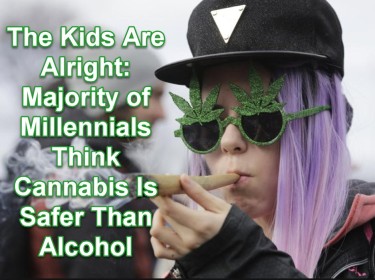
Psychedelics and cannabis use among 19-30 year olds is at an all-time high, according to federal study, and that’s a good thing!
New Federal Study Says Psychedelics and Cannabis Use Among Young Adults Are at All-Time Highs – Why That’s a Good Thing!
The US federal government’s health agency, the National Institutes of Health (NIH), commissioned its latest annual drug use survey to determine rates of use among young Americans.
They found that hallucinogen and cannabis use among the 19- to 30-year-old demographic is at an all-time high, rising in 2021 and reaching record levels not seen since 1988. The study, titled Monitoring The Future (MTF), also found that vaping in this age group has steadily increased since 2021. While many find the vaping trend worrying, it is a much healthier alternative when compared to smoking cigarettes.
Of concern was that alcohol consumption is still high as binge drinking rates have risen again after hitting record lows in 2020. On the plus side, use of cannabis and psychedelics is increasing, and this is excellent news for young adults’ emotional and mental well-being.
“As the drug landscape changes over time, these data provide insight into the substances and patterns of use favored by young adults. We need to know more about how young adults use drugs like marijuana and hallucinogens and the health effects of using different potencies and forms of these substances,” said Nora Volkow, NIH Drug Abuse Director. “Young adults are at a critical time in life and improving their ability to make informed decisions. Understanding how substance use can impact educational decisions in young adulthood is critical to positioning the new generations for success,” she says.
“Overall, the results are very worrying,” says Dr. Volkow. “What they’re telling us is that the problem of substance abuse among young people in this country has been getting worse and that the pandemic, with all of its mental distress and turmoil, has likely contributed to that increase.”
We vote for Dr. Not Volkow, but more on that later.
Another Columbia University study, subsidized by the National Institute on Drug Abuse (NIDA), examined hallucinogenic use among adults and adolescents from 2002 to 2019. The study found similar results, revealing that drug use skyrocketed among those aged 26 and older had risen to 5.5 million by 2019. They also found that hallucinogenic use in the 12- to 17-year-old demographic declined over the same period, which the authors attribute to “prevention efforts in public health as well as changes in policy and availability.” to reduce.”
That’s a good thing, because legalization means that the black market in underage drug trafficking is less successful and regulatory control efforts are stronger than ever.
Why an increase in psychedelics and cannabis use is good news
Decriminalizing hallucinogenic drugs and cannabis is the way to go. Regulating these drugs means those who need the health benefits of these substances can safely obtain medical-grade versions rather than those sold on the streets.
There are many benefits to a growing population indulging in hallucinogenic drugs. Holding these substances illegally is of no use.
For example, there is an overview of 6,000 studies analyzing more than 40,000 patients and the effects of psychedelics on them. These have been used as experimental treatments to treat a range of conditions including alcoholism, recidivism, schizophrenia, depression and autism in children. Participants ranged from scientists to artists, creatives and engineers.
The researchers found that just one LSD session was effective in reducing problem alcohol use in 59% of participants suffering from alcoholism. This is important given the serious health risks associated with alcoholism and its societal harm, as drunk driving is associated with road accidents and injuries.
Additionally, another study conducted by the University of Alabama at Birmingham (UAB) found that classic psychedelics such as LSD, magic mushrooms, ayahuasca, dimethyltryptamine, and mescaline were associated with a reduction in antisocial criminal behavior. The results of the study suggest that treating people with these substances has the potential to reduce criminal behavior.
Researchers analyzed the association between criminal activity and psychedelics use in 480,000 adult participants in the United States over a 13-year period. Participants were asked about their historical use of classical psychedelics. They found that psychedelics use resulted in a 27% reduction in the likelihood of theft or theft, a 22% reduction in the likelihood of being arrested for property crimes, a 12% reduction in the likelihood of assault and a 18% led in the likelihood of being arrested for violent crimes.
On the other hand, they found that the illicit use of other substances was associated with an increased likelihood of criminal behavior.
“These results, coupled with older and emerging evidence, support that classical psychedelics may offer lasting benefits for law enforcement populations,” said Peter Hendricks, Ph.D., UAB associate professor in the Department of Health Behaviors. “They certainly suggest that clinical research involving classical psychedelics in forensic settings should be considered.”
“Classical psychedelics can induce primary mystical experiences — also known as primary religious experiences or pinnacle experiences — and have been used for thousands of years across cultures with therapeutic intent,” he adds.
“Developing innovative and effective interventions to prevent criminal behavior is an obvious priority,” said Hendricks. “Our results suggest that the protective effect of classical psychedelics use is due to genuine reductions in antisocial behavior rather than improved arrest evasion. Simply put, the positive effects associated with classic psychedelic use seem reliable. Given the cost of criminal behavior, the potential this treatment paradigm represents is significant.”
THE YOUTH MOVEMENT INTO NATURAL MEDICINE, READ MORE…

WHY MILLENIALS THINK CANNABIS IS SAFER THAN BOOZE READ THIS!

Post a comment: